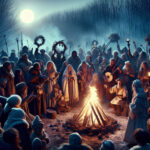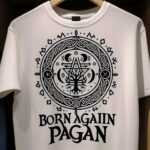The Pagan Invasion of Europe during the Middle Ages is an important event in history that has been largely ignored or misunderstood. This article seeks to explore the reasons for the invasion and its implications for Europe, providing a much-needed insight into the events of this period. It will look at the motivations of the pagans and the impact they had on the region, as well as the religious, political, and cultural changes that followed in their wake. In the end, a better understanding of the Pagan Invasion can provide us with a clearer picture of the Middle Ages, and how this period shaped the world we live in today.

The Pagan Invasion was a period in history that saw the spread of the pagan religion from the Eastern Mediterranean region to the rest of Europe. It was a time of great religious change, with a large influx of new religious beliefs and practices. This period of time has been studied for centuries, and continues to be a source of fascination for many people.
The Origins of the Pagan Invasion
The Pagan Invasion began in the 4th century CE, when the Roman Empire was in decline. During this time, there was a great influx of pagan beliefs and practices from the Eastern Mediterranean region. This region had been heavily influenced by the Greek and Persian cultures, and these beliefs were adopted by the Romans. As the Roman Empire weakened, these beliefs spread throughout the region, eventually reaching Western Europe.
The Spread of Paganism
The spread of paganism across Europe was a gradual process. It was aided by the Roman Empire’s decline, which allowed the spread of new ideas and beliefs. Additionally, the spread of Christianity, which was gaining popularity throughout the region, also helped to spread the pagan beliefs.
The Conversion of the Franks
One of the most significant events in the spread of paganism was the conversion of the Franks. The Franks were a Germanic tribe who had converted to Christianity in the 5th century. However, by the 7th century, they had become disillusioned with Christianity and began to adopt the pagan beliefs of their Germanic ancestors. This was a major turning point in the spread of paganism, as it allowed the pagan beliefs to become more widespread in the region.
The Impact of the Pagan Invasion
The Pagan Invasion had a major impact on European culture and religion. It was responsible for the adoption of new beliefs and practices, which in turn had a significant impact on the development of European culture. Additionally, it helped to create a more diverse religious landscape, with various beliefs and practices coexisting in Europe.
The Pagans in Europe
The Pagan Invasion brought with it a variety of new beliefs and practices. These included the worship of gods and goddesses, the practice of ritual magic, and the use of herbal remedies. Additionally, pagan beliefs and practices were adopted by various cultures in Europe, such as the Celts and the Anglo-Saxons.
The Decline of Paganism
The Pagan Invasion eventually came to an end in the 11th century, when Christianity had become the dominant religion in Europe. As Christianity spread, it was able to suppress pagan beliefs and practices. By the 15th century, paganism had been largely eradicated from Europe.
Conclusion
The Pagan Invasion was a period of great religious change in Europe. It saw the spread of new beliefs and practices from the Eastern Mediterranean region to the rest of Europe. This period of time has been studied for centuries, and continues to be a source of fascination for many people. The Pagan Invasion had a major impact on European culture and religion, and helped to create a more diverse religious landscape. Ultimately, the spread of Christianity led to the decline of paganism in Europe, and by the 15th century it had been largely eradicated.
In conclusion, it is clear that the Pagan Invasion had a significant impact on the development of Europe. It brought with it a new set of beliefs and practices, which eventually led to the spread of Christianity throughout the continent. The Pagan Invasion also brought with it new forms of art, literature, and architecture, which helped to shape the culture of Europe. The Pagan Invasion was a major event in European history, and its effects can still be seen today.





